James Maliszewski's Blog, page 29
February 9, 2025
How Big Was Your Gaming Group?
That makes sense to me, but I hadn't really considered it, since my earliest gaming group was relatively large – seven of us, including myself. We were occasionally joined by others, so our numbers would occasionally creep up closer to ten. In the circles in which I traveled, groups this large weren't uncommon, though I wouldn't go so far as to say they were the norm. In my experience, four to six players (including the referee) was more typical. Even so, I can't recall ever coming across anyone whose group consisted of only two or three people. That's completely outside my own experience.
With that in mind, I thought I'd create a little poll to gather some data about this question. Please take a moment to answer the question below, bearing in mind that it's about your earliest gaming group, which is to say, the one with whom you first played after entering the hobby. At the moment, I'm not interested in data about your current gaming group, so please keep this in mind when answering. Feel free to include any additional details you think relevant in the comments to this post.
Loading...Note: I opted to use another method of polling. Let's see if this one works better. Apologies if you voted in the previous version. You'll need to vote again.
February 7, 2025
One Player, One Character
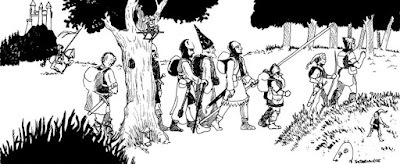 Though I'm pretty sure that almost no roleplaying game actually states this in its text, it's nevertheless a fairly common idea that each player has only one character. On the surface, it makes sense. If playing a RPG is about, on some level, experiencing an imaginary world through the eyes of an equally imaginary persona, then I can see the argument that allowing a player to have more than one character at the same time would hamper or at least dilute that experience. In general, this seems to have been the default approach – one character per player – I've encountered while playing roleplaying games over the years. It's not universal, mind you, but it's very common.
Though I'm pretty sure that almost no roleplaying game actually states this in its text, it's nevertheless a fairly common idea that each player has only one character. On the surface, it makes sense. If playing a RPG is about, on some level, experiencing an imaginary world through the eyes of an equally imaginary persona, then I can see the argument that allowing a player to have more than one character at the same time would hamper or at least dilute that experience. In general, this seems to have been the default approach – one character per player – I've encountered while playing roleplaying games over the years. It's not universal, mind you, but it's very common.There are probably a number of explanations for the prevalence of this approach. A significant one, I believe, is the way that, as the hobby expanded to include more players who'd never previously been involved in wargaming like myself, the frame of reference changed. Roleplaying was no longer viewed by reference to military campaigning but instead became analogized to novel series or television series, with the player characters being its protagonists. I'm sure others can find even earlier examples, but I always recall that, in his foreword to his 1981 revision of Dungeons & Dragons, Tom Moldvay states, "Sometimes I forget that D&D® Fantasy Adventure Game is a game and not a novel I'm reading or a movie I'm watching."
We can argue about whether this approach is the "right" one or not – honestly, I don't really care one way or the other. However, as I said, I think it's a pretty widespread approach and has been for a long time. In some of the campaigns of my youth, this was the assumption, while in others, it was not. For example, I've never run or played in a Traveller campaign where any player had multiple characters. Meanwhile, it's been quite common in the D&D campaigns in which I participated. In my old Emaindor campagn, nearly every player had at least two characters, one high-level and one mid or low-level. This practice grew out of necessity rather than any principle. Sometimes, a character would die and be replaced or sometimes players wouldn't show up as often to sessions and, therefore, their characters would lag in experience. To deal with this, we had "multi-level" campaigns. They all took place within the same setting, but there were different parties or groupings of PCs, all adventuring and sometimes crossing paths with one another.
Because my House of Worms Empire of the Petal Throne campaign has been ongoing for just shy of a decade now, it has a very expansive cast of characters. The main group all belong to the House of Worms clan, but, as the years have worn on, additional characters have come into their orbit, becoming new player characters in the process. During their many years governing the Tsolyáni colony of Linyaró, some of the characters remained in the colony to handle administrative matters while the others explored the wilds of the Achgé Peninsula. During that time, new characters were created to replace those who stayed behind. Likewise, the wives, retainers, and slaves of certain characters were added into the mix as secondary characters. What was happening in the campaign determined which characters were played.
In the Barrett's Raiders Twilight: 2000 campaign, the group of characters was initially small – only seven, one for each player. In time, though, the group picked up a stable of secondary characters, too. The largest group of them joined while the PCs were in Kraków. Because of the overabundance of sergeants, we decided as a group that we needed to introduce some enlisted personnel to fill out the roster. That's how Aquaman, Bedford, Oddball, Rocket Man, and others entered the campaign. Later, Dumont, Landry, and Walker of the 8th Canadian Hussars and Walker of the US 3rd Cavalry entered as NPCs but served as occasional secondary characters, when needed.
I could probably go on with other examples, but I think I've made my point. In thinking about this, I'm starting to think that secondary (or "back up") characters are more common, though not exclusive, to long campaigns, those that last more than a couple of years. They make much more sense in the context of a large, freewheeling campaign that's gone to a lot of places and done a lot of things. Shorter, more focused campaigns tend to be much more like Tom Moldvay's analogy of a novel or TV show. That's because long campaigns eventually start to be about the campaign itself rather than about the characters. The setting and its events looms large and, while it may not take the spotlight completely away from the "main" characters, it does diminish their importance somewhat. If my past and recent experiences are any indication, it can be a lot of fun.February 5, 2025
Regrets
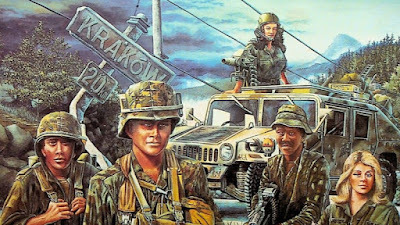
I've been writing a lot more about my Barrett's Raiders Twilight: 2000 campaign lately – partly because the campaign is, after three years of play, on the verge of seeing the characters return to the USA and partly because I now know that readers actually enjoy periodic updates about the games I'm currently refereeing. I'd already been intending to spend more time writing about games other than Dungeons & Dragons, so this is good. There's quite a lot to talk about when it comes to both Twilight: 2000 more generally and my campaign in particular.
As Barrett's Raiders prepares to enter a new phase, I found myself reflecting back on what's happened so far. By and large, I'm pretty happy with the result. There have been plenty of ups and downs over the years – what campaign doesn't have those? – but, taken as a whole, I feel as if this has been an enjoyable campaign with lots of memorable moments. It's still a long way from House of Worms in terms of longevity, of course. However, according to my usual metric of judging a campaign's success, namely, whether or not players keep showing up week after week, Barrett's Raiders is a winner.
That said, I do have one significant regret: I didn't have a Session Zero.
I've never been a big fan of the whole Session Zero concept. My preferred approach, when starting a new campaign, is simply to do a short write-up for all involved, outlining the kind of campaign I hope to run, as well as its framing, and then let the players go off into their separate corners to generate their characters. If they have questions, I'm happy to answer them, but I don't like to guide the process too much, nor do I want the other players to interfere in each others' character creation process (whatever that might be).
In the case of Barrett's Raiders, I laid out for the players the basic scenario: the characters were all survivors of the US 5th Mechanized Infantry after the disastrous Battle of Kalisz in July 2000. Their ragtag band's initial mission is simply to survive. If they succeed in doing that, they should attempt to make it back to NATO lines and, theoretically, safety. Beyond that, I didn't say much else, leaving everything up to the players' judgment. As I said, I answered any questions the players asked, like "Is it OK if I player a Russian POW?" Otherwise, though, I was pretty hands-off.
My laissez-faire attitude had a couple of unintended consequences. First, the characters consisted of too many sergeants. Aside from Lt. Col. Orlowski, all the other military characters were sergeants of one grade or another. There were no corporals, privates, or specialists. Neither were there any other officers, not even a lieutenant. While it's true that the characters' unit was a haphazard one made up solely of survivors of the 5th, the odds that so many would be sergeants strains credibility. Consequently, the early days of the campaign saw Orlowski musing aloud, "What I wouldn't give for some privates or even a corporal!" Eventually, this weird imbalance was fixed somewhat, with the introduction of secondary characters (more on that in a future post), but it bedeviled the campaign for a while.
The second unintended consequences concerned the expectations of the players. Some of the players had already played an earlier edition of Twilight: 2000. Others were merely familiar with it. Others still were complete neophytes. Furthermore, my own take on the game, though generally in line with GDW's original vision for it, was somewhat idiosyncratic. For me, T2K is a game about both survival and, more importantly, rebuilding. I wasn't interested in refereeing a campaign about nihilistic carnage in post-apocalyptic Europe (or America). No, I wanted the campaign to be about picking up the pieces after the nukes had already fallen. In a weird way, I was interested in a very idealistic campaign in which people came together to put the world back together after madness had shattered it.
Not everyone in the campaign fully understood this and it took time to get that point across. Despite being a game about playing soldiers, I don't bog sessions down with combat. Combat occurs, of course, but it's not the focus of the campaign. I'm fascinated by more human topics, like dealing with other survivors, navigating the politics of post-war Poland, and the toll all of this takes on everyone involved. Because I didn't make this clear enough early on, there have been some sessions where things didn't go as well as I (or the players) might have liked. Fortunately, we're now all on the same page and these misunderstandings rarely occur anymore.
Could these unintended consequences have been avoided with a Session Zero beforehand? Maybe. I don't know. As I said, I've never been a huge fan of Session Zero as a concept. Some of it is just curmudgeonliness on part, but some of it comes from a deeply held belief that good campaigns aren't planned – they just happen. I don't like to put my fingers on the scale, so to speak, preferring to let things evolve naturally. That doesn't always work and perhaps that speaks to the utility of Session Zero. In the case of Barrett's Raiders, I do think the early months of campaign might have gone more smoothly if I'd been clearer about my intentions. Likewise, if the players had generated their characters together, they might have been a more cohesive unit from the start.
Live and learn!Aliens, Human and Non-human
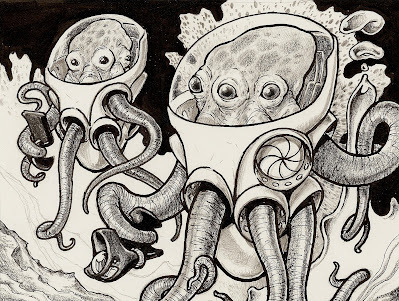
Writing about the Solomani and the existence of different human races within Traveller's official Third Imperium setting reminded me of the approach I opted for when creating Thousand Suns. One of my cardinal principles was that alien species would, for the most part, never be humanoid in appearance. I'd try, whenever possible, to make my alien species alien, both in mind and body. That's why, for example, one of the main antagonistic species of the game's meta-setting are cephalopods – I wanted them to be as far from human in appearance as possible, while still being somewhat relatable.
Science fiction roleplaying games have an unlimited "budget" when it comes to imagining non-human species, so there was no reason to restrain my imagination. At the same time, Thousand Suns is still very much a space opera in the vein of most popular SF. Even if my goal was to be a bit more grounded than other space operas, I'm still including stuff like faster-than-light travel that are almost certainly within the realm of fantasy. Consequently, I make no claims that my non-human aliens are necessarily plausible from a xeno-biological perspective. I simply wanted them to look and think differently than human beings when possible. I believe that makes them more compelling allies and adversaries within the game.
Even so, I retain an affection for human "aliens," which is to say, humans whose cultures or societies are so different that they think or act in ways that are unlike what we typically encounter on Earth. The Zhodani of the Third Imperium setting are the kind of thing I mean. In Thousand Suns, I naturally included Terran humans as a baseline species, but I also introduced the idea of clades or sub-species of Terrans, who'd been genetically engineered in the past for a specific purpose and have since developed their own unique societies and cultures.
For instance, there are the Myrmidons, who are a bit like the Dorsai of Gordon R. Dickson – born and bred for war and having a society driven by Social Darwinism. They're my answer to the Klingons or the Jem'Hadar of Star Trek, an attempt to include the "proud warrior race" archetype that's not quite as lazy as it's usually portrayed. Whether I succeeded or not is a separate question, but that was my goal. By making the Myrmidons a sub-species of human rather than a non-human race, I hoped I could focus more on their harsh society than one their biology, since that's (for me anyway) the real draw of this archetype.
There are other clades besides the Myrmidons, like the rationalist Delphic. They're also a baseline option for play and fill the role of Star Trek's Vulcans and similar space opera species. Since the Thousand Suns rulebook includes an alien creation system, I assumed referees would use it to create their own clades. My plan was to provide more examples of my own, too, in later supplements to the game, but, as I've said, I never quite got round to that. As I've found myself focusing more on science fiction these past few weeks, it's possible I might return to that project. Time will tell.February 4, 2025
Retrospective: Alien Module 6: Solomani
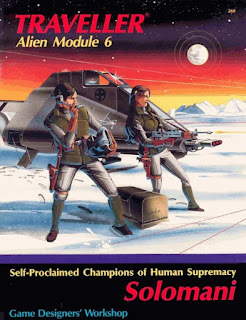 I was thinking about the next installment in my Traveller Distinctives series and thought I'd hit upon a good topic – until I realized that the topic in question was actually an aspect of GDW's official Third Imperium setting and not Traveller more broadly. However, I still thought it was a good topic, so I decided I'd discuss it in the context of Alien Module 6: Solomani, first published in 1986, which is quite late in the era of classic Traveller (Its successor, MegaTraveller, would come out the next year).
I was thinking about the next installment in my Traveller Distinctives series and thought I'd hit upon a good topic – until I realized that the topic in question was actually an aspect of GDW's official Third Imperium setting and not Traveller more broadly. However, I still thought it was a good topic, so I decided I'd discuss it in the context of Alien Module 6: Solomani, first published in 1986, which is quite late in the era of classic Traveller (Its successor, MegaTraveller, would come out the next year).The Third Imperium setting does something I find quite interesting: it postulates that, at some point in the distant past, about 300,000 years ago, an advanced alien species known colloquially as "the Ancients," visited Earth (or Terra) and took from it small populations of its native species, which they then experimented upon and used as servitors. Among these were early homo sapiens. After the Ancients seemingly destroyed themselves in a war amongst themselves, many of the humans whom they brought to the stars were left to their own devices to adapt and evolve without further interference. Some of these lost children of Earth survived and prospered, while others did not.
The psionic Zhodani, rivals of the Third Imperium, are one group of transplanted humans who rose to greatness in the absence of the Ancients. Another group – perhaps even more significant to the history of the Third Imperium – were the Vilani, whose "Grand Empire of the Stars" once ruled more than 15,000 worlds at its height before coming into contact with the humans the Ancients left behind on their original homeworld. These humans, the Terrans, had just discovered jump drive and were expanding out into the galaxy, when they discovered, much to their surprise, that the Vilani had already laid claim to most of them. Undeterred, they launched a series of Interstellar Wars that, over the course of a couple of centuries, brought the Vilani empire crashing down.
Like the Macedonians' conquest of the Persian Empire, the Terrans quickly established themselves at the head of a new hybrid regime, the Rule of Man, which laid claim to all of the Vilani's territory and more. To distinguish themselves from the humans of Vland (the Vilani), the Terrans began to refer to themselves as the Solomani, the men of Sol. The term Solomani thus refers to the descendants of those humans whom the Ancients did not take with them to the stars hundreds of millennia ago. Instead, they remained on Terra, to develop on their own, free from the meddling of other species.
I've always liked this aspect of the Third Imperium setting. Many science fiction settings include innumerable near-human species – Star Trek is notorious for this – that make little sense from an evolutionary perspective. By postulating that there are dozens of human species scattered throughout the galaxy by the Ancients, the setting sidesteps the need for such implausible aliens. Instead, we get three major human races (Vilani, Zhodani, Solomani), all of whom discovered jump drive independently, and a multiplicity of minor human races, who did not, but who might nevertheless have unique and interesting histories and cultures of their own.
Now, if you detect a hint of superiority in the major/minor human race distinction, you're not wrong. The question of what constitutes a major race is a contentious one within the Third Imperium setting and tinged with dark political overtones. This is especially true in the case of the Solomani, who, as the centuries wore on, came to see themselves as the "true" humans. Had they not, after all, been born on Terra herself, the mother world of all humans? Had they not achieved interstellar flight on their own and then, in short order, overthrown the Vilani imperium to found an even greater one? These attitudes eventually hardened into claims of outright supremacy over not just other humans but non-humans too.
Not all Solomani hold to these views, of course. However, a political movement, known as the Solomani Party, espouses them, even to the point of feeling that the Third Imperium – successor to both the Vilani Grand Empire of the Stars and the Solomani Rule of Man – is an illegitimate government and thus unworthy of ruling over Terra and its people. The result was the Solomani Rim War and the secession of a large portion of the rimward territory of the Imperium (though not Terra, which remained in imperial hands). Since then, the Solomani Confederation, with its human supremacist ideas, has been a thorn in the side of the Imperium, with irredentist groups on Earth engaging in terrorism and fomenting unrest.
Like all previous Alien Modules, this one provides everything needed to play and use Solomani characters in the Third Imperium setting. There's history, politics, technology, character generation, and even an adventure. Particular attention is given to the Solomani Party and its sinister enforcement arm, Solomani Security (or SolSec). Like the Gestapo or KGB, SolSec serves as both a secret police force and as a hedge against members of the Party failing to toe the official line. The Solomani government is thus set up as antagonistic both to the Imperium and any Solomani within the Confederation who hope to see it reform by moving away from its ideology.
As enemies, I'm a big fan of the Solomani. I find them much more relatable than the Zhodani, who, despite being human, are quite alien in their thought processes and, therefore, society. By contrast, the Solomani are us – our descendants, twisted by an abhorrent ideology and seething at how far they've fallen from the glory days of their ancestors, who toppled the Vilani empire. It's a great basis for villains with intelligible motivations. They also show how to make use of the history of the Third Imperium setting to create fun adventures and campaigns – the true mark of a good setting element.The Dead Need No Chairs
February 3, 2025
REPOST: The Articles of Dragon: The Inner Planes
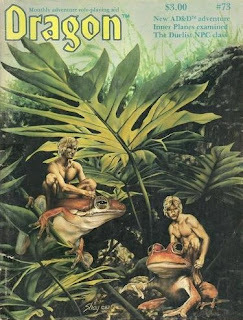 I've commented before that, while I'm no fan of Unearthed Arcana as eventually published, I was conversely a big fan of much of the material Gygax was creating in preparation for his never-written second edition of Advanced Dungeons & Dragons. This material appeared in the pages of Dragon over the course of several years, presenting new classes (like the barbarian, cavalier, and thief-acrobat), weapons and armor, spells, and monsters, along with expanded conceptions of other aspects of the game. At the time, I liked these articles simply because they provided me with more stuff to use in my AD&D campaign (and use them I did). Now, though, what I like about them is the way they seem to represent a maturing of Gygax's fantasy conceptions, the fruit of years of thought and play, not to mention the need for AD&D to find new frontiers of adventure.
I've commented before that, while I'm no fan of Unearthed Arcana as eventually published, I was conversely a big fan of much of the material Gygax was creating in preparation for his never-written second edition of Advanced Dungeons & Dragons. This material appeared in the pages of Dragon over the course of several years, presenting new classes (like the barbarian, cavalier, and thief-acrobat), weapons and armor, spells, and monsters, along with expanded conceptions of other aspects of the game. At the time, I liked these articles simply because they provided me with more stuff to use in my AD&D campaign (and use them I did). Now, though, what I like about them is the way they seem to represent a maturing of Gygax's fantasy conceptions, the fruit of years of thought and play, not to mention the need for AD&D to find new frontiers of adventure.His article, "The Inner Planes," which appeared in issue #73 of Dragon (May 1983), demonstrates this maturation process quite clearly, I think. In it, Gygax offers "a new way to look at the AD&D world." This new way was necessary because, as the game's cosmology evolved, there was a need to reconcile new conceptions to earlier presentations. The para-elemental planes, for example, arose out of wondering about what happens at the point where two elemental planes met. Gygax obviously liked the idea, but soon realized that the thought process that led to them was incomplete. After all, there were other Inner Planes, like the Positive and Negative Material Planes, the Ethereal Plane, and the Plane of Shadow (the latter itself a recent addition to the cosmology). How did they interact with the Elemental Planes and what was the effect of all this interaction?
The result is a cubic representation of the Inner Planes, as depicted in this cut-out included on page 13 of this issue:

"What a mess!" you might reasonably say and it is a mess – an ugly, convoluted, and probably unnecessary one at that, but I love it all the same. There are a couple of things I like about this, starting with the fact that it's clearly an attempt by Gygax to think about AD&D's cosmology in rational way. If para-elemental planes arise due to the meeting of two elemental planes, what happens when an elemental plane meets the Positive or Negative Material Plane? What about a para-elemental plane? The result is baroque, almost to the point of absurdity, but it makes sense. One might argue that this is little different than debating how many angels can dance on the head of a pin and I'm somewhat sympathetic to that point of view. At the same time, given what Gygax had already established about the game's metaphysics and the interactions of those metaphysical forces, this oddly colored cube is a natural, even inevitable, evolution of it all.
That's the second thing I like about this new presentation of the Inner Planes: it's evolutionary. What I mean by that is that it demonstrates that AD&D and the fantasy world it presented was growing and changing, not in a way that, strictly speaking, repudiated anything about its earlier self but rather in a way that added to and expanded upon what had come before. None of this was needed by players or referees solely interested in dungeon crawls or wilderness exploration or all the usual activities of fantasy roleplaying. However, players and referees interested in going beyond that would find it invaluable. Gygax was taking a lot more interest in the other planes of existence, seeing them as the next logical step in exploring the possibilities implied by AD&D's setting. To do that properly, he'd need to think about them more carefully, teasing out the implications and taking stock of all they could offer. Whether one likes the direction he was headed or not, I hope one can nevertheless appreciate the effort.The Perils of Verisimilitude
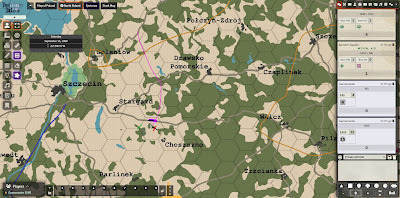 Twilight: 2000, especially in its current Free League version, is very much a game of hexcrawling. The characters spend a great deal of time traveling across the war-torn Poland of an alternate year 2000, trying to survive, avoid Warsaw Pact forces, and, with luck, find their way back to friendly territory. The map above – apologies for its small size – is from the Foundry virtual tabletop we use to play the game. Its hexes are all 10 kilometers across for ease of calculating overland movement. Even at this size, you can see that the map is very stylized, focusing only on very large terrain features, like cities, forests, rivers, roads, etc.
Twilight: 2000, especially in its current Free League version, is very much a game of hexcrawling. The characters spend a great deal of time traveling across the war-torn Poland of an alternate year 2000, trying to survive, avoid Warsaw Pact forces, and, with luck, find their way back to friendly territory. The map above – apologies for its small size – is from the Foundry virtual tabletop we use to play the game. Its hexes are all 10 kilometers across for ease of calculating overland movement. Even at this size, you can see that the map is very stylized, focusing only on very large terrain features, like cities, forests, rivers, roads, etc.For the most part, this isn't a problem. Despite its subject matter, Free League's Twilight: 2000 doesn't get bogged down in minutiae, preferring instead to keep things relatively streamlined. Thus, the degree of resolution in its travel maps is low. High-level features are visible, while more localized ones don't make an appearance at all. For example, the roads on the map are all (mostly) major highways. They're obviously not the only roads in Poland, but the maps don't bother with showing backroads. Putting details like that on the map would only make them harder to read, so they're left to the referee to include as he sees fit.
The situation is made a little more complicated by several other factors, though. Remember that the original Twilight: 2000 was published in 1984 by an American game company. Its knowledge of the geography of Communist Poland was probably not wholly accurate, not due to a lack of industry on the part of the game's designers but because it wasn't easy to get up-to-date information of that sort from behind the Iron Curtain. This was before the commercial Internet, too, so you'd have to consult physical map books if you wanted to know anything about, say, the roads of Poland at the time. But of course Twilight: 2000 wasn't even set at the time. It was set sixteen years in the future, so whatever information GDW had access to in '84 would probably have been out of date by the time in which the game was set anyway.
Free League is in a slightly better position. Since this version of the game was published in 2021, it has the benefit of hindsight. Its designers could look back at maps of Poland from the 1990s and use those to produce a more "accurate" version of the terrain, right? Not necessarily. Even in their version of Twilight: 2000, which uses a slightly different history than did GDW's version – I'm using my own history, which is closer but not identical to GDW's – the USSR continued to exist into the year 2000. That means looking at maps of the real world from the '90s might not reflect what happened in this alternate reality – or they might; it's hard to say.
I mention this, because, during the course of the Barrett's Raiders campaign, the characters would often find themselves in some hex or other. The players would inevitably have questions about the specific terrain in what looked, on the map, to be a largely empty hex. What was the elevation like? Where there any farmhouses or buildings? What about dirt roads? Etc., etc. Usually, I'd make something up on the spot and that would be that. However, players would sometimes think they could be helpful to me by making use of Google Earth to show us an image of what an area "really" looks like. For example, here's an image of the area above from Google Earth:
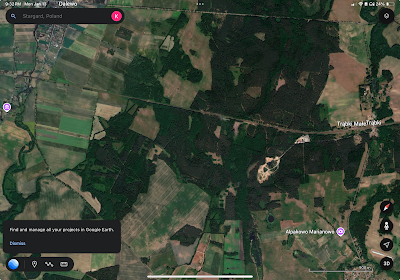 There are innumerable differences, big and small, between this image and the travel map from the Foundry. If you look carefully, you can see that not only does the Google Earth image include features that aren't visible on the travel map, but that the travel map is, in fact, wrong in a lot of places. That is, the Foundry travel map suggests that many areas are, for example, forested when, in reality, they're farmland. That's not a big deal, I suppose, but it demonstrates a way in which modern tools, like Google Earth, can make the referee's job harder rather than easier.
There are innumerable differences, big and small, between this image and the travel map from the Foundry. If you look carefully, you can see that not only does the Google Earth image include features that aren't visible on the travel map, but that the travel map is, in fact, wrong in a lot of places. That is, the Foundry travel map suggests that many areas are, for example, forested when, in reality, they're farmland. That's not a big deal, I suppose, but it demonstrates a way in which modern tools, like Google Earth, can make the referee's job harder rather than easier.Harder? Yes. When a player finds information like this and offers it up, thinking he's being helpful, the referee now has to decide, "Which do I use: the game map or the real world map?" The real world map offers many advantages, often including extra detail that can be timesaving. No longer would the referee need to make up details on the fly. Instead, he just needs to zoom in on Google Earth and look (assuming that area has that level of detail – not all places do). Furthermore, such online tools are readily accessible nowadays; there's no need to go fumbling through a book or books. It's all right there.
Acknowledging all that to be true, I ultimately decided against using Google Earth or similar things, opting instead to use the often-inaccurate travel maps. They were, to my mind, both simpler and less likely to lead us down an endless path of checking ever more specific sources of detailed information. Every time the characters crossed a river, how wide is it? What's its depth? What kind of fish can be found in it? Etc., etc. I don't deny that such stuff can be useful and, for many people, perhaps that's exactly what they're looking for. More power to them! For me, I'd prefer to keep the details entirely within my own control. Will I get many wrong? Absolutely – but that's OK, because, in the grand scheme of things, it probably won't matter.
Obviously, everyone will draw their lines in different places. There may be some details they absolutely want to get right, while there are others that won't matter. As everyone reading this knows, I care a lot about, say, language and so, for instance, I care about the various dialects of Polish but not so much about where bridges across the Vistula River are actually located. Another referee may reverse these concerns or care about both or neither. At the end of the day, it's your game; do what you want with it. For me, I decided against relying on real world maps for my alternate universe version of Poland at the dawn of the 21st century. You may feel differently.
Terror Was Never This Much Fun
From issue #86 (June 1984) of Dragon comes one of the first advertisements for Pacesetter's horror RPG, Chill, that I ever saw. The accompanying artwork, by the late, great Jim Holloway, is quite effective, though it's a bit unclear where the mutton-chopped fellow is standing. Is he standing in an open grave? If so, where's that sinister hand coming from? If he's not, where are the gentleman's legs? So many questions!
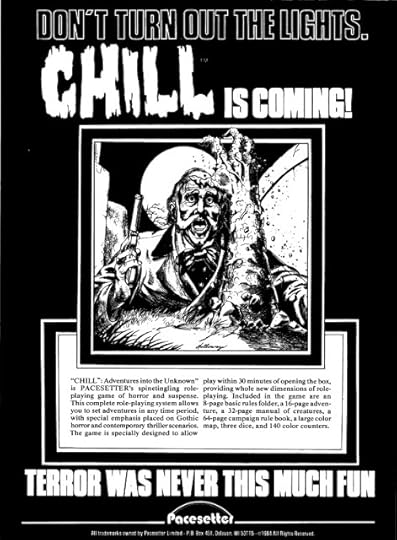
February 2, 2025
Campaign Updates: T2K and EPT
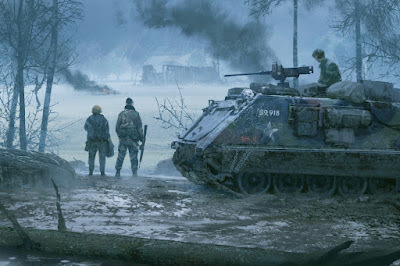 As promised, I'm going to start writing short posts in which I update you about what's going on in the various campaigns I'm refereeing (the ones in which I'm playing are another matter). I say "short," because it's been my experience that even people who genuinely want to hear about your RPG campaign aren't all that interested in a blow-by-blow discussion of everything that transpires. I suspect that's one of the reasons – but not the only one – that my old House of Worms session recaps weren't all that well received: they were too detailed. Tékumel is a pretty alien setting as it is; getting down into the weeds of our latest session only made things worse. Lessons learned!Barrett's Raiders
As promised, I'm going to start writing short posts in which I update you about what's going on in the various campaigns I'm refereeing (the ones in which I'm playing are another matter). I say "short," because it's been my experience that even people who genuinely want to hear about your RPG campaign aren't all that interested in a blow-by-blow discussion of everything that transpires. I suspect that's one of the reasons – but not the only one – that my old House of Worms session recaps weren't all that well received: they were too detailed. Tékumel is a pretty alien setting as it is; getting down into the weeds of our latest session only made things worse. Lessons learned!Barrett's RaidersMy Twilight: 2000 campaign has been going for just a little over three years now, having started in December 2021, shortly after the release of Free League's edition of the game. The characters began the campaign shortly after the disastrous Battle of Kalisz in July 2000, their unit of the US 5th Mechanized Infantry cut off NATO lines and fleeing pursuit by Polish and Soviet forces of the Warsaw Pact. To escape, they fled south before heading southeast in the direction of the ruined city of Częstochowa. By mid-September of the same year, they'd successfully evaded capture and, after many adventures, were headed back west, with the intention of hooking back up with friendly forces.
In the course of their travels, they ambushed a Soviet truck that was carrying a very unusual cargo: a medium atomic demolition munition or MADM, colloquially known as a nuclear landmine. The MADM was obviously of US manufacture. How the Soviets had come into possession of it or why it was on the back of a GAZ-66 truck traveling the backroads of central Poland the characters have yet to discover. All they know is that the MADM is the rightful property of the US government (whichever one you prefer) and that it ought not to be in Soviet hands. So, for the last little while, there's been added urgency to not being captured, lest a nuclear device fall into the hands of the enemy.Presently, the characters are just south of the city of Stargard, which, if rumors are to be believed, is not far NATO-controlled territory in northwest Poland. However, while making their way there, they discovered that they were being followed. Rather than allow events to overtake them, Lt. Col. Orlowski, their commander, decided to take the initiative. The unit made use of the terrain to fortify themselves and their vehicles, as well as sending out a reconnaissance team to scout the area. They soon learned that their pursuers were a Spetsnaz GRU hunter-killer team of maybe a dozen or so men and a BMP-1 fighting vehicle.
The Spetsnaz were obviously intent on reclaiming the MADM. This hampered their ability to attack with full effect, as they did not wish to damage the device. The characters took full advantage of this and, after a few minutes of intense fighting, won the day. However, Lt. Col. Orlowski was uncertain if they'd successfully taken out all of the Spetsnaz and so will likely order the unit to leave the area quickly, hoping to reach safety before reinforcements arrive. Given the high value of what they're carrying, he expects they'll be pursued for some time to come yet.
House of Worms
The announcement of the death of emperor Hirkáne Tlakotáni has started the clock on the next Kólumejàlim, the "choosing of the emperor" by which his successor will be chosen from amongst his heirs, both known and hidden. There is a one-month period of mourning throughout Tsolyánu, but especially in the capital of Béy Sü. This period also gives all Hirkáne's heirs the time needed to travel to Béy Sü to present themselves to the Omnipotent Azure Legion as possible candidates for the many trials that make up the Kólumejàlim.
Of course, to do that, an heir must present to the OAL an inscribed golden disc that was given to their guardians at the time of their birth. In the case of public heirs – those whose identities are already known – this is usually a simple matter. In the case of hidden heirs, intrigue is possible. Sometimes, the clan or temple to whom an heir was entrusted may decide, for whatever reason, not to advance the heir for consideration. In other cases, they may choose to substitute a different candidate, using the disc as "proof" of the new candidate's identity. Since there is no way to know for certain – most heirs are given to their guardians as infants – this is an accepted part of the Tsolyáni succession system.
One of the player characters, Kirktá, is a hidden heir to the Petal Throne. Though he will probably not present himself as a candidate for the Kólumejàlim, the other characters don't want to waste this opportunity. An heir who "renounces the gold," which is to say, publicly withdraws himself from consideration after announcing himself, can nevertheless reap great rewards. He will typically be given some sort of imperial sinecure and perhaps more, especially if he wisely throws his support behind the heir who ultimately becomes emperor.
Unfortunately, the circumstances of Kirktá's early life are filled with strange and indeed suspicious events, one of the most important being that he does not know the location of his golden disc. Therefore, he can't present himself as an heir when the time comes. Presently, the characters are busy investigating the matter, trying to locate it. They suspect the disc is held either by someone in his former Red Sword clan or someone in the Temple of Belkhánu, to which he once belonged. Until the disc is located, though, Kirktá's status – and any hope of gain stemming from it – are very much up in the air.
James Maliszewski's Blog
- James Maliszewski's profile
- 3 followers



